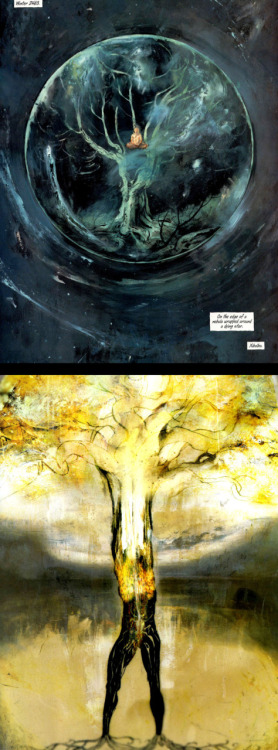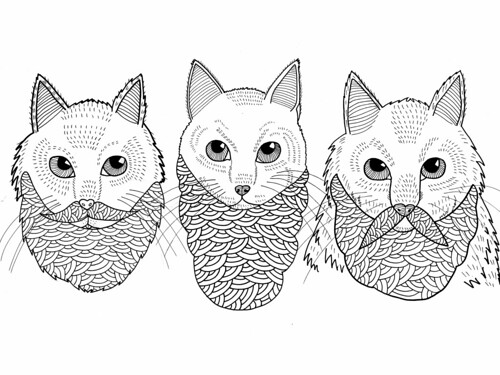1) What led you to develop the style you use now?
I guess it's all the shit I've been slowly absorbing my whole life, from childhood until now. I've always loved cartoons and comics, especially the visually weird ones. I used to draw my favorite characters endlessly. I remember filling like 6 binders with nothing but simpsons drawings on lined paper. And XMen. I used to love drawing them. Heh. But when I became older I started appreciating painting. My uncle bought me a set of oil paints and I used to follow along with Bob Ross tutorials and copy famous landscapes. Then in highschool I used to draw comics and photocopy them and hand them around. I went to school at Sheridan, here in Toronto. I applied for animation but I didn't get accepted, so I took a 1 year "art fundamentals" course. I'm so glad I did, because my time in that course lead me to my ultimate decision to devote my life to illustration (instead of animation, THANK GOD!). I loved the illustrations I saw around the school. The whole notion of perfecting your "style" really appealed to me, and I really wanted to come up with something that was all my own. I wanted to have people look at my pictures and feel my emotions, or at least to look at them and know that they were made by a person who feels deeply. But when I tried, it just came out all wrong. Sure I was good enough to get good grades, but I would struggle and torment myself over my 'style'. I mean, how should I paint? What should my pictures say? How can I possibly express the emotions I want to express when I'm not a classic or abstract painter, but someone who grew up watching cartoons and playing video games? I filled 32 sketchbooks in my 5 years of college (5 of them were filled with nothing but drawings of my left hand lol). I absorbed a retarded amount of visual stimulation. I followed the contemporary illustration scene. I learned as much as I could about my favorite classical and modern painters. I watched a ton of cartoons. I drew all day, every day. My commute to school was 2 hours each way, so I would bring a portable mixed media art kit with me. It must have been a funny sight to see, at 6am on the train surrounded by business men, some 20 year old kid with a huge sketchbook, cutting photos out of the newspaper and painting, inking, & gluing in a giant sketchbook. And even after college, although I never had a problem finding work, I still didn't feel like I had the 'style' that I'd been searching for. And as the years following school passed, with all the commercial & computer illustration commissions I was getting (see doodlemachine.com, my 'company', for examples), I drifted further away from my search for 'my style'. It was only a few years ago that I finally started to please myself. And it was because I started painting again, but this time just for me. I made my workshop into a painting studio and started painting for the first time since school. Then I became addicted. I was painting like a demon. Just tons and tons of painting, and although lots of them sucked it felt great to 'get the bad ideas out of the way', as I said. I have stacks & stacks of bad paintings in my shop as we speak. Then one day, quite by accident, I painted "stargazer" (the first painting on my site, it says 2009 but that's a lie - I think it was early 2008). And it was the first time, in my whole life, that I'd made a picture that felt like 'me', just exactly what I'd been trying to do. Something that was the culmination of all my influences, from Samurai Jack to Picasso, from Photoshop to Van Gogh, from Mario to Matisse. I just stared at it for days, trying to figure out what about this picture pleased me so much. And as soon as I started 'thinking too hard', I started making garbage again. And I worried it might be a one hit wonder, that it was a total fluke and I'd never hit that height again. So eventually I stopped worrying about it and again started painting for my own enjoyment. Then I had another victory. Then another. And eventually I got the message. Just don't TRY and paint or draw a certain way. Don't overthink your style. Just absorb as much awesome art as you can, draw & paint as much as humanly possible, and 'you' will start to shine through your pictures. It's actually quite beyond your control. At least, it was for me. I'm sure there are illustrators out there who saw a style, said "I can do that better", then did, and now they're famous for it. But that's a different road to success, one that I have no experience in. If you're asking me about style, my only advice is to just love art, love drawing, love painting, feel deeply, and that's all you can do. And that's plenty.
2) Night-time motifs seem to be common in your pieces, is there a story to
that?
I'm a nighthawk. I stay up til 5am every night. When the sun comes up, I go to bed :P. I love the stars & the moon. I love space. I love the dark. I feed off the dreams of the sleeping masses, so I guess my obsession with the night is somewhat of an ode to the creative energy it brings me. I'm probably much paler than I should be...
3) What was your favorite professional assignment? Favorite personal piece?
My favorite personal piece is "Falling Downwards".
My favorite professional assignment is harder to pinpoint. I guess I like the products I've illustrated for, like the board games & magazine covers. But no single specific thing. Yet. It's actually probably this children's book I'm working on right now called "It Rained Goats", but I can't show it off yet (stay tuned though!). Sorry, that's a hard question to answer. I haven't had that "eureka" moment in my commercial life yet. Just lots of somewhat enjoyable projects that pay the bills (and quite a few not so enjoyable ones).
4) What do you do when you can't come up with ideas or where do you go for
inspiration?
That's tough. I try to not go anywhere for inspiration when I'm in a state of writer's block because I always find I just get influenced by something and try to do 'my version' of it, which never feels right. So when I can't come up with ideas, I force myself to keep working. I lock myself in my workshop and pace back & forth, sometimes almost tormenting myself for hours at a time. I'll sit with my eyes closed. I listen to tons of music. I'll take coffee breaks or go for long walks. But the one thing I forbid myself to do is just go to the internet for ideas. It's too easy. It's not satisfying. And when you force yourself to be inspired on your own terms, that's where the most growth happens. That's when you make those pictures that surprise yourself. Sometimes it takes even days to come up with something worth painting. But it's always worth the wait.
5) Whats the best advice would you give an aspiring illustrator/student?
I have 2 sets of advice:
1. To make money:
- become a jack of all trades. Learn painting, animation, video editing, audio editing, photoshop, illustrator, flash, web design, 3d design... everything you possibly can. Find as many ways to be creative as you can, and the cumulation of all of them is what will get your life to a sustainable state. I'm very well rounded, and that's the key to my commercial success. It's just about never having to say "No, I don't do that" when an opportunity comes along. I do basically every single job that comes to me because I've learned all the tools of the trade. Also, the more places you can be found, the more contacts you'll make. The internet is vast & [mostly] free promotion. Just spend time putting yourself out there and the jobs will come.
2. To make no money:
- Do everything I said earlier. Paint & draw for you alone. Love what you do. Don't ever be bored or boring. This life is too short to worry about how the world will accept you, how to turn your craft into financial stability, or how to be 'famous'. Just find a good place for yourself where you can root & grow.
*note - a 40%/60% mix of 1 and 2 is my recipe, although it'll be different for everybody.
6) How do you advertise yourself/get work?
There's lots of luck involved. It's just about the right client finding you at the right time. I have my websites, andrejolicoeur.com & doodlemachine.com. I sell stock illustration (that's a taboo subject, don't tell anyone I said that :P ). I post my pictures on various online portfolio sites (the free ones, there are several good paid ones but I'm cheap). I get lots of word of mouth business. I get lots of small jobs that turn into bigger jobs when they realize I do other stuff, like web design or animation. I take part in group exhibits and gallery shows in Toronto, where I'm always giving out promotions and business cards. I won a few entries into illustration annuals a while back, but they never really yielded anything, so these days I just focus on spreading myself around in any free manner that I can find. Oh, and making minecraft texture packs. That's brought quite a bit of traffic to my site all of a sudden. Heh.

















































